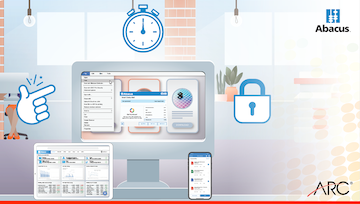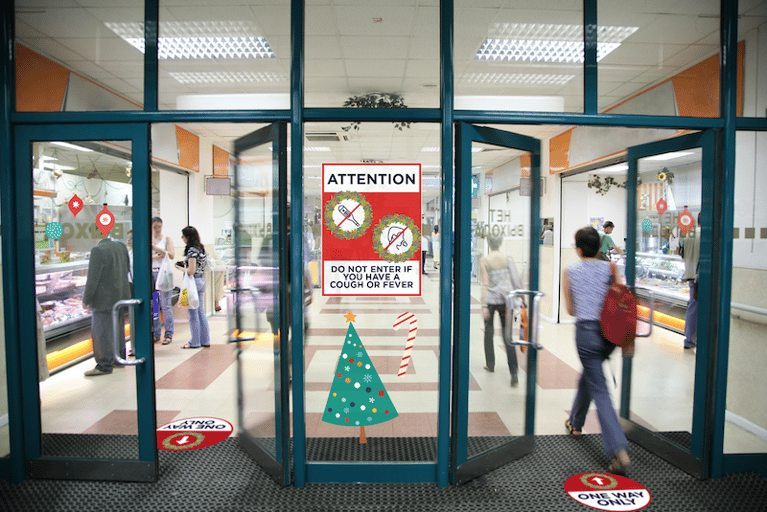Paper is an obsolete archiving media. It wastes space, is disorganized and is not immediately accessible. How much would it cost to replace the critical information contained in your paper archive? And how accessible is your information to easily update, collaborate and share with other team members in different groups and locations?
Nick Miller, national director of professional services at ARC®, and I spoke during a webcast recently to discuss the benefits of applying search capabilities to an entire collection of paper documentation. Paper is not going away, but transitioning it to a digital solution can have a profound, positive effect on how you work. In this webcast, we’ll give you five actionable steps to take to exit from paper.
Or read the transcript:
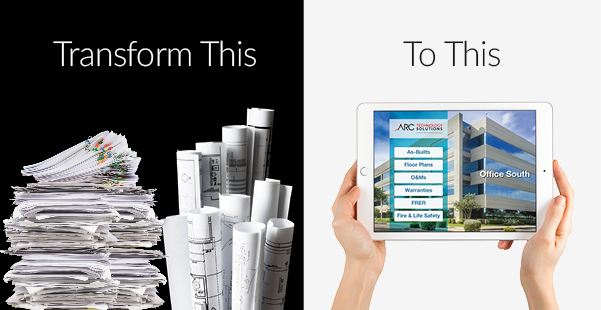
Your Exit Strategy From Paper
Kari (moderator): Welcome Nick and Rick! We appreciate you being here.
Nick: Thank you for having us.
Kari: Rick you often say paper is in the past, can you share with us what you mean by that and why this is so important to understand?
Rick: As Kari has said, paper is an obsolete archiving media. The problems with paper are manifold. Paper:
- Takes up a lot of space and is therefore an inefficient use of real estate.
- Is not very accessible.
- Lives in one place so if you want information you or someone working for you has to visit the collection to extract what you need.
- Is not necessarily archival. The information you store upon it can degrade over time.
- Is subject to many potential perils, fire, flood, theft, or casual loss.
- Without constant active management, paper becomes disorganized and therefore difficult to search and less valuable to you as a resource.
Nick: I think you hit the nail on the head there, Rick. For a long time, that’s the way things were done but with advances in technology we have today it’s absolutely not the preferred medium.
Kari: Alright with that being said, we believe there’s a better way. So Nick could you share with us why?
Digital is Now…and the Future
Nick: To speak to the bullets on the screen there.
- Redundancy creates and eliminates the risk of content being lost whether that’s due to as Rick alluded to flood, fire, disaster, or potentially the original copy is taken from the room and never brought back. The question we like to ask typically is, how much would it cost to replace the intellectual property contained in your paper archive? We find that’s a huge number for a lot of organizations and the paper medium is very dangerous from a risk perspective.
- Access to content should not be limited by your location or your connection to an internal server. We find that giving access to the content to a broader audience with editing permission, being limited to those who need that permission, creates a better end-user scenario where they can consume the content they need and receive updates in real-time. And then obviously, it makes collaboration with external and internal team members much easier, when that process doesn’t have to start with a manual search and scan for distribution purposes.
- The paper archive is limited to data that can be stored on paper specifically. So using a digital solution means that all content associated with the organization can be stored in one place. This may be videos to demonstrate processes, that may be pictures of existing site conditions, it could be design files that are being collaborated on.
- All of that is more convenient when you can store all of those things in the same place. Related to structured data, metadata, and search tags, I like to ask the question…currently when someone asks me for any kind of information, I don’t ever go to an encyclopedia to find an answer to something, I Google it! So our thought process is let’s apply that same Google-like search capability to your entire organization’s collection of documents so that you could use it to find any piece of information on any page in your company’s repository.
Benefits of Going Digital
Kari: Rick, why don’t you continue on and tell us the benefits of going digital?
Rick:
- I think the first benefit is making access to the information more accessible and therefore eliminating inefficient use of labor within your organization. If you can shorten the time between when you decide you need something and actually retrieving it, you can allow your staff to devote time to higher-value activities.
- The second benefit is, you run the potential of eliminating storage within high-value office space. If you can do that by converting on-site storage to digital, you can either re-purpose that existing space or shrink your real estate footprint and enjoy the reduced cost.
- The third benefit I can think of would be using the digital benefits of that digital information to support a retention work-flow that ensures that you keep the information you have for the required time, and that you also know when it is time to purge it from your system. This would help avoid any potential legal or regulatory problems.
- And then finally, by establishing a work process that keeps your content in digital form, you avoid accumulating another inefficient paper collection in the future.
The Dangers of Doing Nothing
Kari: Nick, can you share with us the dangers of doing nothing? Or even trying to do something in-house?
Nick: The biggest risk associated with doing nothing are typically the following:
- Obviously, the risk of losing intellectual property due to disaster or content not being brought back.
- The labor inefficiencies that Rick described due to inability to find the content quickly.
- The loss of tribal knowledge i.e. how to find information when employees leave, means slower up-times for new employees. The process of finding information becomes an inherent process to the people who work there. When someone leaves an organization, you lose that knowledge on how to find information.
- The lack of ability to respond in a mission critical situation, so I have an emergency on-site the last thing I want to do is spend hours looking for the information we need to respond to the emergency.
- The big one that we find is falling behind competitors who are doing something. If you’re not doing it that doesn’t mean that your competitors aren’t. And if your competitors can respond quicker in critical situations, if they are working more efficiently, then that creates a challenge for you as an organization.
- The big thing about doing the process in-house or internalizing it is that a lot of times we find our customers are simply migrating their paper problem to a digital problem, using bad file naming, bad folder structuring, the ability to find content isn’t actually increased by moving to a digital medium.
Rick: I would simply reemphasize your last point about falling behind the competition. It’s a pretty ruthless business environment out there these days, people are looking to get any efficiencies they can, and if you don’t take a critical look at how you store and share your information, you’re probably going to fall behind your competition.
Kari: Now we have some ideas for you to exit paper, can you discuss for us the first strategy?
Exit Strategy Step 1: Ability to Find Information
Rick: The big thing about doing an archive is establishing this critical ability to find information.
- It’s important to engage a knowledgeable consultant to help you determine how you
- currently find information
- validate what information you need associated with the documents in order to find them in a digital format
- and have the consultant actually validate that you, or the service provider, can find that information and associate it with the documents.
- They should also talk to you about the interplay between search tags and the ability to interrogate the internal content of the document and how those would work together.
Kari: Rick, what is your next exit strategy is?
Exit Strategy Step 2: Digitizing and Indexing
Rick: Sure. Once you worked with that consultant and established how you’re going to search your collection then the collection actually needs to be digitized and indexed.
- And when I say “indexed” that search information associated with those individual documents, kind of like little electronic post-it notes.
- Since this is likely the most expensive component of the archiving process, it’s vital that it be preformed by a competent, efficient, and experienced service provider.
- One of the key items you want to evaluate with that prospective service provider is what their chain of custody practices are. This is key to validating that all of your paper content is converted to an equal digital collection.
- It’s also important during the process, especially if you have a large collection, that if you need something retrieved, that the service provider has an ability to find it while they’re preforming the digitization process and return that component to you.
The archiving center should be highly secure both physically and in terms of web access. This will ensure that your intellectual property is safe during the digitization. We have a graphic here that shows the typical workflow for a competent document conversion.
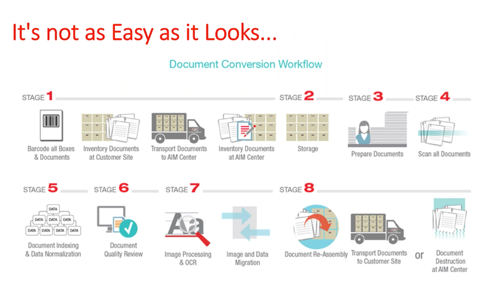 Workflow for a competent document conversion
Workflow for a competent document conversion
As you can see managing this conversion of a large paper archive into a searchable digital one is not an easy process.
If your prospective service provider does not follow a similar clearly documented work-flow, I would say that you would be headed for trouble. So please be very diligent about your evaluation in this process of the conversion.
Nick: Yeah, so typically I find this is the biggest differentiator for us. This work-flow, the ability to tell you step by step what will happen, and our chain of custody. It’s absolutely the most critical step we take.
Kari: Thanks, Nick. Nick can I get you to continue on and share with us step 3
Exit Strategy Step 3: Find a Home for Your Information
Nick: Yeah, absolutely. So, finding a home for your information.
- The act of digitizing and indexing your documents is not a complete solution.
- It does help to lower the risks of keeping your documents viable long-term but it typically provides very little productivity or efficiency gains.
- Utilizing an enterprise content management software that makes finding information easier is an absolutely necessary step in your exit strategy. It takes the guessing game out of the long-term equation that is referencing documentation.
- The enterprise content management solution you choose should help eliminate the work needed to find the information you need on a day to day basis.
I have lots of customers tell me they have no issues looking for information, it’s all about being able to find it. Having a centralized solution where that content can reside, be maintained, updated, and distributed to all team members is an absolutely critical step in this strategy.
Kari: I know that we hear a lot about thumb drives and things like that, which are waiting for people to come up with their own solutions. Would one of you like the address what the trouble is with thumb drives?
Rick: I don’t necessarily have trouble with thumb drives, but there’s an old saying that hope is not a plan and a thumb drive is not an effective archive. I think Nick touched on it earlier, he mentioned that portable digital storage is really just a digital version of your at-risk paper collection.
- Thumb drives represent all the risk qualities of a paper archive, just in miniature form.
- A thumb drive can be lost or stolen. It can be damage.
- Something this small could easily go in the wash (I’ve done it myself)
- The on-board data can be corrupted by extreme elements or exposure to magnetic radiation.
- Finally, oftentimes the data stored in a thumb drive does not have encryption protection so it’s very at risk for loss.
And we poke fun at thumb drives but any rigid portable storage (CD, DVD, even a network attached storage) is at the same risk. So I would say use thumb drives to transport stuff around but do not depend upon them as a meaningful archive.
Nick: I think the real challenge we see is that it’s a great means for temporary storage and people tend to think that it’s a long term solution, but it just doesn’t work in the same capacity for your long term archiving needs.
Kari: Nick, we’re on to our fourth step, would you like to address that for us?
Exit Strategy Step 4: Plan for the Future
Nick: Yeah, sure so planning for the future.
- You know insuring the provider has future proofing built into the archive.
- Many enterprises management content providers utilize a proprietary software and proprietary file formats to ensure that your data is locked into their solution long-term.
- This creates a dependency on the provider and creates a potential hostage situation at some point in time in the future, if you want to when you want to retrieve that content from that archiving solution and put it somewhere else.
- By utilizing an open-ended software solution with no barriers to entry or exit, your intel property remains yours and can be continued to be edited, updated on an on-going basis. As technology and software changes, so should the software you use to deliver the content out to your own consumers.
- Using a cloud-based application also makes the need for yearly software purchases non-existent and allows our customers to consume only the content that they need to pay for only based on what they are consuming at that time.
- I find that to be a much more flexible situation for our customers and typically future-proofing is where the value comes from.
We don’t want to tie anything back to a proprietary file format that limits your ability to use that in or out of our system.
Rick: Well I’d simply point out that any solution provider that looks like a hostage taker, you should really think twice about partnering with them. It tells me that they don’t have full confidence in their solution and you should look for someone who does not hold your content hostage.
Q&A
Jessica: I do have some questions. Shelly typed in that she’s probably not the average listener but as a sole proprietor who still drafts, what is the most cost effective way to:
- Start archiving old drawings
- and how to go forward with new work?
Rick: I think the first step is to simply get started because once you have your foundation in place, it’s very simple to add content to your collection. I would look at the legacy collection vs. your active documents. Decide which of those is most critical to your business operation and begin the digitization process with that portion of the collection first. If you choose the active documents first, you can then piece-meal and attack the legacy documents at a later date knowing full well that the foundation and structure that you established with the current document archive allows you to simply add it to the collection.
Nick: I think you’re exactly right there Rick. I think having a go-forward strategy and a legacy document strategy is very important. Attacking those two things differently, based on need and primary function and day to day activities, is absolutely the way to go.
Rick: Right and I think that if the date defines it’s relevancy if you tackle the go forward first, and then in reverse date order take on the legacy documents, you’re getting the most relevant ones into the system as you go.
Nick: And more importantly you’re eliminating the need to potentially save data that is not relevant to you anymore. You can use that to determine if this content is no longer needed, and you can begin to implement a retention policy for your content as well.
Jessica: Next question is what’s an example of where someone’s collection would live and how to search for it?
Nick: Okay, I’ll go to our archiving solution.
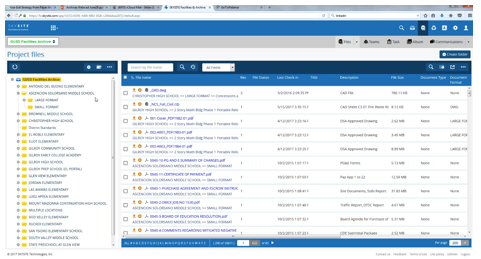
- So here you can see a collection, this is actually a school district in California. They have organized their file structure based on their different school sites, but when they want to search the collection they don’t go here, they go to an advanced search window. And I’ll show you a quick search here.
- What we’re going to do is use metadata or search tags, we’re going to look at documents relevant to this particular school site.
- Then what we’re going to do is use in-document search to search for this name within this subset of documents for this school so down at the bottom you see we have nearly 17,000 documents here.
- We click search and we get a return of 2 documents. Now, notice here it says “view keyword matches.” Before we download or open this document, we can actually take a preview look and see what’s the context for where this name was found on this document and we see that it lives on page 61 of a multi-page document.
- I can click here and actually view that page on that 112 page document and right there you can see the name. And this looks like it’s a list of customers for a pool plastering company.
- So, in our old way of looking for this on paper this could’ve taken 30 minutes, it could’ve taken 4 hours. Here, we were able to go not to a particular document but to a particular page on a document in a matter of seconds.
Jessica: The other question built off of that is how many search tags do you need to make this effective?
Rick: Oh that’s a good question. This is one of those things where more is not necessarily better. There’s really a declining value in adding more search tags. We’ve found that for typical, even large collections, no more than 4 or 5 search tags are needed in concert with in-document search to find anything you need. The key is choosing the right search tags, and that’s why step 1 in digitization process that Nick talked about is so important. You need a consult with an experienced consultant who has looked at many collections and identified the best practices to find information efficiently.
So the short answer, I would be surprised if any particular collection needed more than 5 or 6 search tags.
Jessica: I have another question from Thomas. He asks are scans or digital done in house at ARC and at what cost per page?
Nick: Absolutely done in house. We’ve got 170 service centers so we can typically do it locally, relative to where you are in the United States. The cost per page is heavily dictated by:
- the size of the piece of information you’re scanning,
- the quality of the output you’re looking for,
- and the existing quality of that document
- it is something we try not to give blanket pricing on. We do want to do a consultation with you, maybe see the content and volume of content before putting a price on it.
But from that perspective, that is absolutely something we can localize and have someone on site help with that process.
Rick: Before you move on, something I would add to what Nick said, we do have numerous locations throughout the US that can provide the digitization process. However, for very large customers with higher security concerns, we do have regionally dedicated archiving centers that can provide the highest level of security while their collections are being digitized.
Jessica: Marie-Rose has a question she’s asking, how do you mitigate the possibility of a file format or a storage medium becoming obsolete?
Rick: File formats change throughout time, we’ve watched that happen. I think it’s not that we can prevent them from becoming obsolete, but we need to have a plan and a process for managing the conversion of potentially obsolete file formats. Given the fact that we encourage highly popular, universal file formats to begin with, if that file format is headed for sunset, we have the ability to help our clients do mass conversion to the next preferable file format.
Kari: Nick and Rick, excellent information and I appreciate your time and all of the information you shared with us today. So again everyone thank you for being here, Nick? Rick? Any final comments?
Rick: All I would add is if you are currently relying on a paper archive, please do not underestimate the potential value to your organization to make that conversion. We’ll be happy to help you sort through the pros and cons of that and determine which is the best fit for you.
To learn more, request a demo today!
